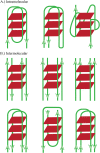G-Quadruplex Structures in Bacteria: Biological Relevance and Potential as an Antimicrobial Target
- PMID: 33649149
- PMCID: PMC8315935
- DOI: 10.1128/JB.00577-20
G-Quadruplex Structures in Bacteria: Biological Relevance and Potential as an Antimicrobial Target
Abstract
DNA strands consisting of multiple runs of guanines can adopt a noncanonical, four-stranded DNA secondary structure known as G-quadruplex or G4 DNA. G4 DNA is thought to play an important role in transcriptional and translational regulation of genes, DNA replication, genome stability, and oncogene expression in eukaryotic genomes. In other organisms, including several bacterial pathogens and some plant species, the biological roles of G4 DNA and G4 RNA are starting to be explored. Recent investigations showed that G4 DNA and G4 RNA are generally conserved across plant species. In silico analyses of several bacterial genomes identified putative guanine-rich, G4 DNA-forming sequences in promoter regions. The sequences were particularly abundant in certain gene classes, suggesting that these highly diverse structures can be employed to regulate the expression of genes involved in secondary metabolite synthesis and signal transduction. Furthermore, in the pathogen Mycobacterium tuberculosis, the distribution of G4 motifs and their potential role in the regulation of gene transcription advocate for the use of G4 ligands to develop novel antitubercular therapies. In this review, we discuss the various roles of G4 structures in bacterial DNA and the application of G4 DNA as inhibitors or therapeutic agents to address bacterial pathogens.
Keywords: G-quadruplex; antigenic variation; aptamers; homologous recombination; host-pathogen interaction; transcriptional and translational regulation.
Figures




References
-
- Bang I. 1910. Untersuchungen über die Guanylsäure. Biochem Z 26:293–311.
Publication types
MeSH terms
Substances
Grants and funding
LinkOut - more resources
Full Text Sources
Other Literature Sources

